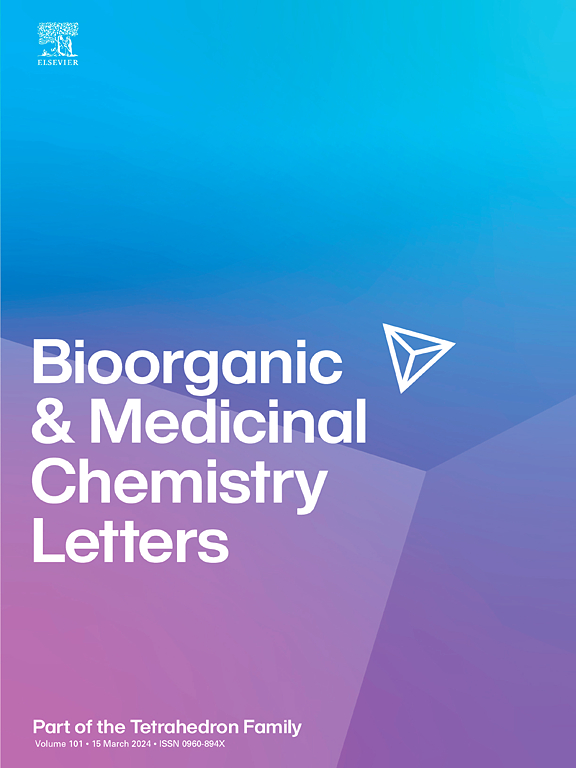Guaiacol–chalcone and nitroguaiacol–chalcone derivatives: In vitro and in silico antibacterial evaluation
IF 2.5
4区 医学
Q3 CHEMISTRY, MEDICINAL
引用次数: 0
Abstract
This study aimed to design and synthesise novel guaiacol–chalcone and nitroguaiacol–chalcone derivatives and determine their in vitro antibacterial activity against five pathogens viz. Staphylococcus aureus, Klebsiella pneumoniae, Acinetobacter baumannii, Pseudomonas aeruginosa and Klebsiella aerogenes. The checkerboard assay was used to explore potential synergism with existing antibiotics to shed light on a possible antibacterial mechanism of action. A pharmacophore model was constructed to identify key chemical entities the derivatives had which are necessary for activity. The pharmacophore model was validated utilising the enrichment factor (EF10 %) and the area under the receiver operating characteristic (ROC-AUC) curve metrics. The most active derivative was nitroguaiacol–chalcone derivative 2c (8 µg/ml), with activity against susceptible and methicillin-resistant strains of S. aureus. The checkerboard assay showed that one nitroguaiacol–chalcone derivative (2a) had a synergistic effect when combined with chloramphenicol (FICImin: 0.45 ± 0.09), implying its antibacterial mechanism of action might also target bacterial protein synthesis. Active guaiacol–chalcone and nitroguaiacol–chalcone derivatives were accurately identified by the common feature pharmacophore model (max. fit: 4, rank score: 52.34). The leading pharmacophore model, i.e., hypothesis 1 (EF10 %: 8, ROC-AUC: 0.95 ± 0.02) indicated that four features are important for antibacterial activity i.e., a ring aromatic, a hydrophobic moiety and two hydrogen bond acceptors.

愈创木酚查尔酮和硝基愈创木酚查尔酮衍生物:体外和硅内抗菌评价
本研究旨在设计合成新的愈创木酚查尔酮和硝基愈创木酚查尔酮衍生物,并测定其对金黄色葡萄球菌、肺炎克雷伯菌、鲍曼不动杆菌、铜绿假单胞菌和产气克雷伯菌的体外抗菌活性。棋盘试验用于探索与现有抗生素的潜在协同作用,以阐明可能的抗菌作用机制。建立了药效团模型,以确定衍生物具有活性所必需的关键化学实体。利用富集因子(ef10%)和受体工作特性曲线下面积(ROC-AUC)指标对药效团模型进行验证。活性最高的衍生物为硝基愈创木酚查尔酮衍生物2c(8µg/ml),对金黄色葡萄球菌敏感和耐甲氧西林菌株均有抑制作用。棋盘格实验显示,一种硝基愈创木酚查尔酮衍生物(2a)与氯霉素(FICImin: 0.45±0.09)联用时具有协同作用,表明其抑菌机制可能也针对细菌蛋白的合成。利用共同特征药效团模型(max.;拟合度:4,排名得分:52.34)。主要药效团模型即假设1 (EF10 %: 8, ROC-AUC: 0.95±0.02)表明,四个特征是影响抗菌活性的重要因素,即一个环芳香族、一个疏水部分和两个氢键受体。
本文章由计算机程序翻译,如有差异,请以英文原文为准。
求助全文
约1分钟内获得全文
求助全文
来源期刊
CiteScore
5.70
自引率
3.70%
发文量
463
审稿时长
27 days
期刊介绍:
Bioorganic & Medicinal Chemistry Letters presents preliminary experimental or theoretical research results of outstanding significance and timeliness on all aspects of science at the interface of chemistry and biology and on major advances in drug design and development. The journal publishes articles in the form of communications reporting experimental or theoretical results of special interest, and strives to provide maximum dissemination to a large, international audience.

 求助内容:
求助内容: 应助结果提醒方式:
应助结果提醒方式:


